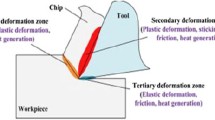Abstract
This paper presents a detailed analysis of tool failure progression through an experimental study of high speed milling of Ti-6Al-4V alloy with CVD (Ti(C, N)-Al2O3)-coated carbide tools. The progressive tool failure characteristics under a variety of different cutting conditions were investigated. Cutting forces components and transient infrared temperature during the machining processes have been measured along with corresponding progressive tool wear when milling using coated carbide inserts under dry machining conditions. Optical microscope and scanning electron microscopic analysis results clearly show the different dominant wear regions at different stages of machining with coated carbide tools. The experimental results demonstrate that the cutting forces and the cutting temperature produced during the machining process showed an increasing trend with the tool failure progression, which in turns accelerated the tool wear progression and caused the change of the tool failure mechanisms. Furthermore, the progressive tool failure mechanisms were analyzed qualitatively. The cutting speed was correlated with progressive tool failure mechanisms, and the different conditions of friction and normal stresses caused by different cutting force and cutting temperature under different cutting speeds resulted in the varieties of progressive tool failure mechanisms.
Similar content being viewed by others
References
Schulz H, Moriwaki T (1992) High speed machining. CIRP Ann Manuf Tech 41(2):637–643
Ezugwu EO, Wang ZM (1997) Titanium alloys and their machinability—a review. J Mater Process Tech 68(3):262–274
Zoya ZA, Krishnamurthy R (2000) The performance of CBN tools in the machining of titanium alloys. J Mater Process Tech 100(1–3):80–86
Ezugwu EO, Bonney J, Yamane Y (2003) An overview of the machinability of aeroengine alloys. J Mater Process Tech 134(2):233–253
Venugopal KA, Paul S, Chattopadhyay AB (2007) Tool wear in cryogenic turning of Ti-6Al-4V alloy. Cryogenics 47(1):12–18
Fang XD (1994) Experimental investigation of overall machining performance with overall progressive tool wear at different tool faces. Wear 173(1–2):171–178
Fang XD, Jawahir IS (1993) The effects of progressive tool wear and tool restricted contact on chip breakability in machining. Wear 160(2):243–252
Ee KC, Balaji AK, Jawahir IS (2003) Progressive tool-wear mechanisms and their effects on chip-curl/chip-form in machining with grooved tools: an extended application of the equivalent toolface (ET) model. Wear 255(7–12):1404–1413
Wanigarathne PC, Kardekar AD, Dillon OW, Poulachon G, Jawahir IS (2005) Progressive tool-wear in machining with coated grooved tools and its correlation with cutting temperature. Wear 259(7–12):1215–1224
Dutta AK, Chattopadhyaya AB, Ray KK (2006) Progressive flank wear and machining performance of silver toughened alumina cutting tool inserts. Wear 261(7–8):885–895
Li HZ, Zeng H, Chen XQ (2006) An experimental study of tool wear and cutting force variation in the end milling of Inconel 718 with coated carbide inserts. J Mater Process Tech 180(1–3):296–304
Calamaz M, Coupard D, Girot F (2008) A new material model for 2D numerical simulation of serrated chip formation when machining titanium alloy Ti–6Al–4V. Int J Mach Tools Manuf 48(3–4):275–288
Sun J, Guo YB (2009) Material flow stress and failure in multiscale machining titanium alloy Ti-6Al-4V. Int J Adv Manuf Technol 41(7–8):651–659
Sima M, Özel T (2010) Modified material constitutive models for serrated chip formation simulations and experimental validation in machining of titanium alloy Ti–6Al–4V. Int J Mach Tools Manuf 50(11):943–960
Özel T, Sima M, Srivastava AK, Kaftanoglu B (2010) Investigations on the effects of multi-layered coated inserts in machining Ti–6Al–4V alloy with experiments and finite element simulations. CIRP Annals - Manuf Technol 59(1):77–82
Chen G, Ren CZ, Yang XY, Jin XM, Guo T (2011) Finite element simulation of high-speed machining of titanium alloy (Ti–6Al–4V) based on ductile failure model. Int J Adv Manuf Technol. doi:10.1007/s00170-011-3233-6
Fischer C (2009) Runtime and accuracy issues in three-dimensional finite element simulation of machining. Int J Mach Mach Mater 6(1–2):35–42
Klocke F, Eisenblätter G (1997) Dry Cutting. CIRP Annals Manuf Technol 46(2):519–526
Rahim EA, Sasahara H (2011) A study of the effect of palm oil as MQL lubricant on high speed drilling of titanium alloys. Tribol Int 44(3):309–317
ISO 8688–2 (1989) Tool life testing in milling—part 2: end-milling. International Organization for Standardization, Geneva
Astakhov VP (2007) Effects of the cutting feed, depth of cut, and workpiece (bore) diameter on the tool wear rate. Int J Adv Manuf Technol 34(7–8):631–640
Kikuchi M (2009) The use of cutting temperature to evaluate the machinability of titanium alloys. Acta Biomater 5(2):770–775
Ai X (2003) High speed machining technology. National Defense Industry, Beijing
Astakhov VP (2004) The assessment of cutting tool wear. Int J Mach Tools Manuf 44(6):637–647
Childs T, Maekawa K, Obikawa T, Yamane Y (2000) Metal machining: theory and applications. Wiley, New York
Varadarajan AS, Philip PK, Ramamoorthy B (2002) Investigations on hard turning with minimal cutting fluid application (HTMF) and its comparison with dry and wet turning. Int J Mach Tools Manuf 42(2):193–200
Liew WYH, Ding X (2008) Wear progression of carbide tool in low-speed end milling of stainless steel. Wear 265(1–2):155–166
Author information
Authors and Affiliations
Corresponding author
Rights and permissions
About this article
Cite this article
Li, A., Zhao, J., Luo, H. et al. Progressive tool failure in high-speed dry milling of Ti-6Al-4V alloy with coated carbide tools. Int J Adv Manuf Technol 58, 465–478 (2012). https://doi.org/10.1007/s00170-011-3408-1
Received:
Accepted:
Published:
Issue Date:
DOI: https://doi.org/10.1007/s00170-011-3408-1




